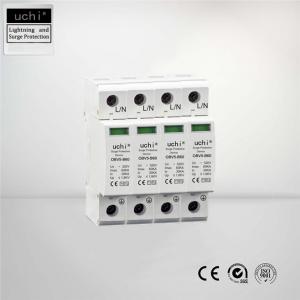
Add to Cart
*Because the high-altitude observation camera is on the top of the building, it is extremely vulnerable to lightning strikes, so lightning protection measures are indispensable.The main methods of lightning damage to high-altitude observation cameras are divided into two types: direct lightning and induction lightning.
1. Protection from direct thunder
To prevent lightning from directly hitting the high-altitude observation camera, the camera needs to be within the protection range of the lightning rod. Nowadays, some buildings do not have lightning rods, only lightning belts, and the camera is at the highest point. In this case, the risk is relatively high, and a separate lightning rod needs to be installed.
Lightning rods are also called lightning rods. The purpose is to make a direct lightning strike on the top of the building, instead of hitting the high-altitude lookout camera, but to connect the lightning rod to the lightning rod.
2. induction mine protection
Inductive lightning hazard refers to the inductive surge generated by lightning electromagnetic pulse (LEMP) invading the equipment through the power line and signal line of the camera and causing damage. Most of the damage caused by lightning in the monitoring system is caused by induced lightning.
Therefore, lightning protection devices should be installed on the power cord and signal line of the camera to protect against lightning induced lightning.
OBV5-B60
The combination lightning current and surge arrestors OBV5-B60 meet the type 1+2 requirement class according to IEC 61643-11. These devices protect low-voltage consumer systems from overvoltages of all types and are available in single-pole to four-pole versions. The use of high-performance varistors permits a rapid response time and a low protection level, without any line follow current. If circumstances are uncertain and there is a risk of fire from an overload, the internal cut-off unit disconnects the arrestor from the mains if necessary. In addition, the QR code printed on the arrestor allows direct access to the online installation instructions.
Technical Parameters
| Model: OBV5-B60 | |||
| Maximum continuous voltage AC | Uc | V | 275/320/385/440 |
| SPD to EN 61643-11 | Type 1+2 | ||
| SPD to IEC 61643-1 | class I+II | ||
| Lightning impulse current (10/350µs) | Iimp | kA | 12,5 |
| Nominal discharge current (8/20µs) | In | kA | 30 |
| Maximum discharge current (8/20µs) | Imax | kA | 60 |
| Voltage protection level | Up | kV | < 1,5/1,8/2,0/2,2 |
| Response time | tA | ns | < 25 |
| Maximum back-up fuse | A | 125 | |
| Temperature range | ϑ | ℃ | -40℃~+85℃ |
| Protection rating | IP 20 | ||
| Max. cable cross-section flexible (fine-wire) | mm² | 25 | |
| Max. cable cross-section rigid (single wire/multi-wire) | mm² | 35 | |

Feature:
1,Protect electric system and on-loading electrical apparatus from thunder and instantaneous over-voltage.
2,Protect transmission of Ethernet signals with 48V DC / 34V AC power supply circuits against
lightning induced surges.
3,Enhanced surge protection.
4,For mounting on 35mm DIN rails acc. to EN 60715
5,It can effectively ensure the equipments work properly
Benefits
Easy installation or retrofit
Din-rail mountable
Fail-safe /self-protected designRemote indicator (optional) with 3pin NO/NC contact
IP20 finger-safe designVisual indicator
Small foot print
Application
●AC/DC distribution
●Power supplies
●Industrial automation
●Telecommunications
●Motor controls systems
●PLC applications
●Power transfer equipment
●HVAC applications
● AC drives
●UPS systems
●Security systems
●IT/Data centers
Others
Technology SPD parameter(Note:According to user requirement ,can be customized Uc=140V,440V,550V,voltage range of range of the SPD):
| Type No. | Rated Voltage(V) Un | Continuous Voltage Uc(V~) | Standard Discharge Current In(KA) | Max Discharge Current | Protection Level(KA~) | Response Time(ns) |
| DGM1(2)-D5 | 220/380 | 275/320 | 5 | 10 | 1.2 | ≤25 |
| DGM1(2)-D10 | 10 | 2 | 1.6 | |||
| DGM1(2)-C20 | 20 | 40 | 1.8 | |||
| DGM13-B30 | 30 | 60 | .2.2 | |||
| DGM3(4)-B40 | 10 | 80 | 2.4 | |||
| DGM(4)-B60 | 60 | 100 | 2.8 | |||
| DGM-N-PE | 220/255 | 40/60 | 60/80 | 1.2 | ≤100 |
Transient voltage surgesin lv power lines
Transient overvoltages are voltage surges that can reach tens ofkilovolts with a duration of the order of microseconds.Despite theirshort duration, the high energy content can cause serious problemsto equipment connected to the line, from premature aging to destruction, causing disruptions to service and financial loss.Thistype of surge can have various different causes, including atmospheric lightning directly striking the external protection(lightning rods) on a building or transmission line or the associatedinduction of electromagnetic fields on metallic conductors.
Outdoor and longer lines are the most exposed to these fields,which often receive high levels of induction.
It is also common for non-weather phenomena, such as transformer centre switching or the disconnection of motors orother inductive loads to cause voltage spikes in adjacent lines.
Importance of theground connection
Overvoltage protectors (SPD) divert excess energy toground, so limiting the peak voltage to an acceptablevalue for connected electrical equipment.
A ground connection in adequate condition is, therefore,a key aspect for effective protection against overvoltages.Monitoring ground connection condition guaranteesproper operation of surge protection devices.
Q: Can I get some samples?
A: Yes, Sample orders welcomed.
Q: Can I use my own Logo or design on goods?
A: Yes, Customized logo and design on mass production are available.
Q:What is the delivery time?
A: 3 days for samples, 7-15 days for mass production.
Q: What is the payment term?
A: T/T, L/C at sight, West union , Paypal, etc.